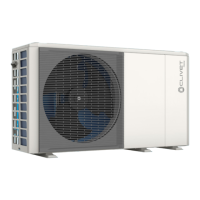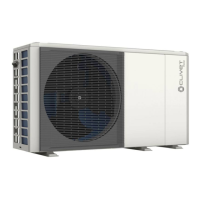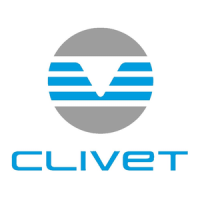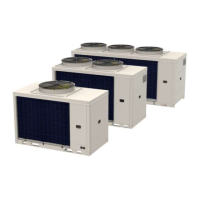59
Residual risks
13. Residual risks
13.1 General
In this section the most common situations are indicated,as
these cannot be controlled by the manufacturer and could
be a source of risk situations for people or things.
13.2 Danger zone
• This is an area in which only an authorised operator may
work.
• The danger zone is the area inside the unit which is
accessible only with the deliberate removal of protections
or parts thereof.
13.3 Handling
• The handling operations, if implemented without all of
the protection necesssary and without due caution, may
cause the drop or the tipping of the unit with the conse-
quent damage, even serious, to persons, things or the
unit itself.
• Handle the unit following the instructions provided in the
present manual re-garding the packaging and in com-
pliance with the local regulations in force.
• Should the refrigerant leak please refer to the refrigerant
“Safety sheet”.
13.4 Installation
Remember that:
• incorrect installation of the unit can lead to water leaks,
condensate accumulation, refrigerant leakage, electric
shock, fire, malfunction or damage to the unit itself
• installation of the unit in a place where even infrequent
flammable gas leaks are possible and the accumulation
of these gases in the area around the unit can cause
explosions and fires
• installation of the unit in a place that is not suitable to
support its weight and/or provide adequate anchorage
may cause it to fall and/or tip over, resulting in damage to
property, people or the unit itself
Check:
• the location of the unit carefully
• that the installation is only carried out by qualified tech-
nical personnel and the instructions in this manual and
current local regulations are followed
• the location of the unit carefully
Easy access to the unit by children, unauthorised persons
or animals may be the source of accidents, some serious.
Install the unit in areas which are only accessible to
authorised person and/or provide protection against
intrusion into the danger zone.
13.4.1 General risks
Smell of burning, smoke or other signals of serious
anomalies may indicate a situation which could cause
damage to people, things or the unit itself.
In this case:
• electrically disconnect the unit
• contact the authorised service centre to identify and
solve the problem causing the anomaly
Accidental contact with exchange batteries, compressors,
air delivery tubes or other components may cause inju-
ries and/or burns.
Always wear suitable clothing including protective
gloves to work inside the danger zone.
Maintenance and repair operations carried out by
non-qualied personnel may cause damage to persons,
things or the unit itself.
Always contact a qualied assistance centre
Failure to close the unit panels, or to check that all panel
xing screws are properly tightened, can result in dama-
ge to property, people or the unit itself
Periodically check that all the panels are correctly closed
and xed
If there is a fire the temperature of the refrigerant could
reach values that in-crease the pressure to beyond the
safety valve with the consequent possible projection of
the refrigerant itself or explosion of the circuit parts that
remain isolated by the closure of the tap.
Do not remain in the vicinity of the safety valve and never
leave the refriger-ating system taps closed.
13.4.2 Electric parts
An incomplete attachment line to the electric network or
with incorrectly sized cables and/or unsuitable protective
devices can cause electric shocks, intoxication, damage to
the unit or res.
Carry out all of the work on the electric system referring
to the electric layout and the present manual ensuring
the use of a system thereto dedicated.
An incorrect xing of the electric components cover may
lead to the entry of dust, water etc inside and may conse-
quently electric shocks, damage to the unit or res.
Always x the unit cover properly.

